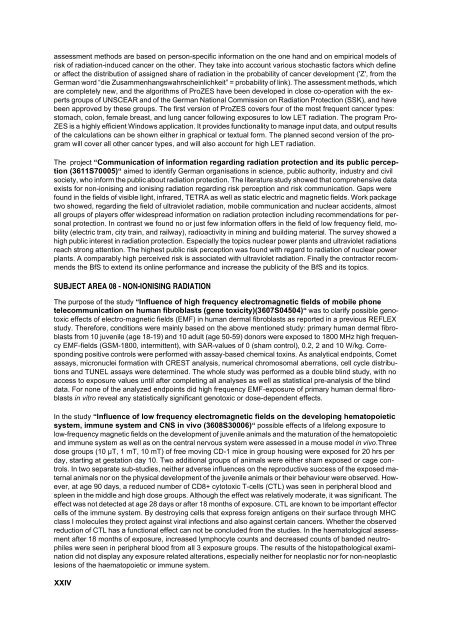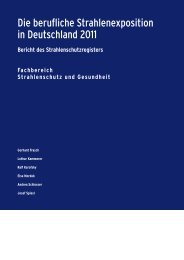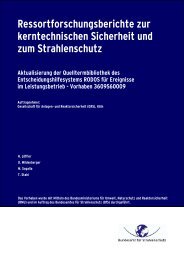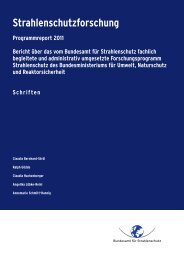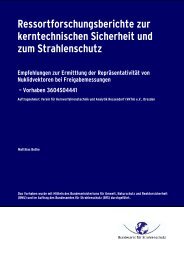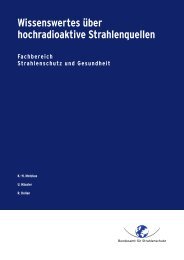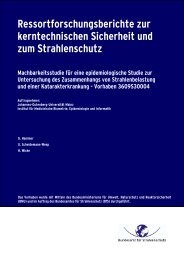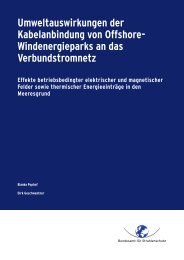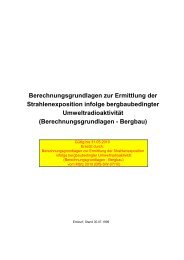Programmreport 2012 - DORIS - Bundesamt für Strahlenschutz
Programmreport 2012 - DORIS - Bundesamt für Strahlenschutz
Programmreport 2012 - DORIS - Bundesamt für Strahlenschutz
Sie wollen auch ein ePaper? Erhöhen Sie die Reichweite Ihrer Titel.
YUMPU macht aus Druck-PDFs automatisch weboptimierte ePaper, die Google liebt.
assessment methods are based on person-specific information on the one hand and on empirical models of<br />
risk of radiation-induced cancer on the other. They take into account various stochastic factors which define<br />
or affect the distribution of assigned share of radiation in the probability of cancer development ('Z', from the<br />
German word “die Zusammenhangswahrscheinlichkeit” = probability of link). The assessment methods, which<br />
are completely new, and the algorithms of ProZES have been developed in close co-operation with the experts<br />
groups of UNSCEAR and of the German National Commission on Radiation Protection (SSK), and have<br />
been approved by these groups. The first version of ProZES covers four of the most frequent cancer types:<br />
stomach, colon, female breast, and lung cancer following exposures to low LET radiation. The program Pro-<br />
ZES is a highly efficient Windows application. It provides functionality to manage input data, and output results<br />
of the calculations can be shown either in graphical or textual form. The planned second version of the program<br />
will cover all other cancer types, and will also account for high LET radiation.<br />
The project “Communication of information regarding radiation protection and its public perception<br />
(3611S70005)“ aimed to identify German organisations in science, public authority, industry and civil<br />
society, who inform the public about radiation protection. The literature study showed that comprehensive data<br />
exists for non-ionising and ionising radiation regarding risk perception and risk communication. Gaps were<br />
found in the fields of visible light, infrared, TETRA as well as static electric and magnetic fields. Work package<br />
two showed, regarding the field of ultraviolet radiation, mobile communication and nuclear accidents, almost<br />
all groups of players offer widespread information on radiation protection including recommendations for personal<br />
protection. In contrast we found no or just few information offers in the field of low frequency field, mobility<br />
(electric tram, city train, and railway), radioactivity in mining and building material. The survey showed a<br />
high public interest in radiation protection. Especially the topics nuclear power plants and ultraviolet radiations<br />
reach strong attention. The highest public risk perception was found with regard to radiation of nuclear power<br />
plants. A comparably high perceived risk is associated with ultraviolet radiation. Finally the contractor recommends<br />
the BfS to extend its online performance and increase the publicity of the BfS and its topics.<br />
SUBJECT AREA 08 - NON-IONISING RADIATION<br />
The purpose of the study “Influence of high frequency electromagnetic fields of mobile phone<br />
telecommunication on human fibroblasts (gene toxicity)(3607S04504)“ was to clarify possible genotoxic<br />
effects of electro-magnetic fields (EMF) in human dermal fibroblasts as reported in a previous REFLEX<br />
study. Therefore, conditions were mainly based on the above mentioned study: primary human dermal fibroblasts<br />
from 10 juvenile (age 18-19) and 10 adult (age 50-59) donors were exposed to 1800 MHz high frequency<br />
EMF-fields (GSM-1800, intermittent), with SAR-values of 0 (sham control), 0.2, 2 and 10 W/kg. Corresponding<br />
positive controls were performed with assay-based chemical toxins. As analytical endpoints, Comet<br />
assays, micronuclei formation with CREST analysis, numerical chromosomal aberrations, cell cycle distributions<br />
and TUNEL assays were determined. The whole study was performed as a double blind study, with no<br />
access to exposure values until after completing all analyses as well as statistical pre-analysis of the blind<br />
data. For none of the analyzed endpoints did high frequency EMF-exposure of primary human dermal fibroblasts<br />
in vitro reveal any statistically significant genotoxic or dose-dependent effects.<br />
In the study “Influence of low frequency electromagnetic fields on the developing hematopoietic<br />
system, immune system and CNS in vivo (3608S30006)“ possible effects of a lifelong exposure to<br />
low-frequency magnetic fields on the development of juvenile animals and the maturation of the hematopoietic<br />
and immune system as well as on the central nervous system were assessed in a mouse model in vivo.Three<br />
dose groups (10 µT, 1 mT, 10 mT) of free moving CD-1 mice in group housing were exposed for 20 hrs per<br />
day, starting at gestation day 10. Two additional groups of animals were either sham exposed or cage controls.<br />
In two separate sub-studies, neither adverse influences on the reproductive success of the exposed maternal<br />
animals nor on the physical development of the juvenile animals or their behaviour were observed. However,<br />
at age 90 days, a reduced number of CD8+ cytotoxic T-cells (CTL) was seen in peripheral blood and<br />
spleen in the middle and high dose groups. Although the effect was relatively moderate, it was significant. The<br />
effect was not detected at age 28 days or after 18 months of exposure. CTL are known to be important effector<br />
cells of the immune system. By destroying cells that express foreign antigens on their surface through MHC<br />
class I molecules they protect against viral infections and also against certain cancers. Whether the observed<br />
reduction of CTL has a functional effect can not be concluded from the studies. In the haematological assessment<br />
after 18 months of exposure, increased lymphocyte counts and decreased counts of banded neutrophiles<br />
were seen in peripheral blood from all 3 exposure groups. The results of the histopathological examination<br />
did not display any exposure related alterations, especially neither for neoplastic nor for non-neoplastic<br />
lesions of the haematopoietic or immune system.<br />
XXIV


